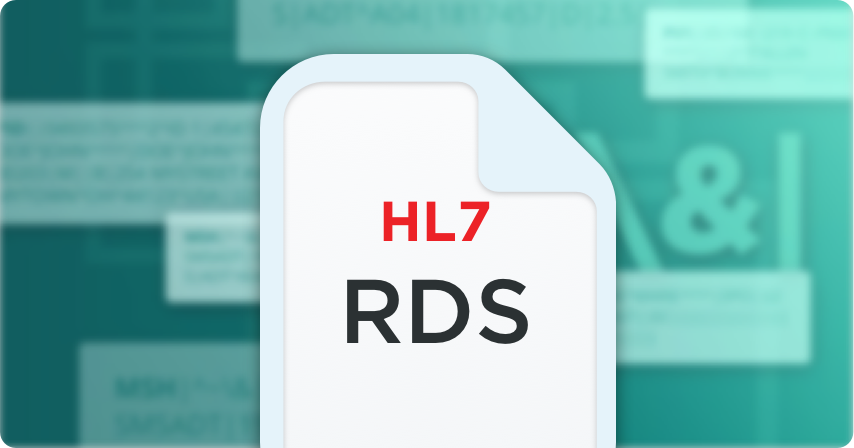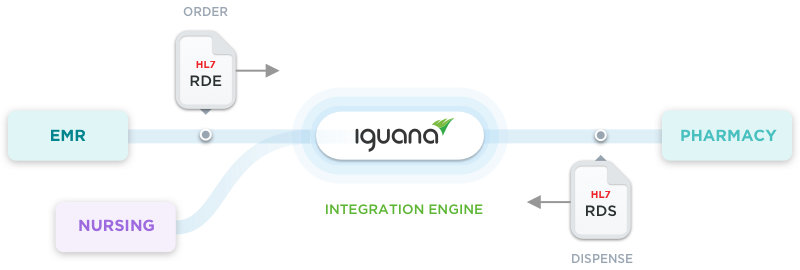The Complete Guide to HL7
HL7 RDS
Pharmacy/Treatment Dispense
An HL7 Pharmacy/Treatment Dispense (RDS) message is used to communicate when a pharmacy application has dispensed medication or treatments to fill an existing order(s).

Pharmacy/Treatment Dispense
An HL7 Pharmacy/Treatment Dispense (RDS) message is used to communicate when a pharmacy application has dispensed medication or treatments to fill an existing order(s).

Example RDS message use case: When the pharmacy dispensing system has collected the HL7 RDE Pharmacy/Treatment Encoded Order message, the dispensing system will fill the order. It will then send the ordering application (ie. an HIS or EMR) and other clinical applications (ie. a nursing system) an HL7 RDS message to communicate information and instructions about the medications dispensed or treatments prescribed.

Below is an example of an HL7 version 2.5 RDS^O13 message. The trigger event O13 was introduced in the HL7 v2.4 standard. Event O01 was used in previous versions.
| Segment | Description |
|---|---|
| MSH | Message Header. The header contains information about the sending system and location, the receiving system and location, and the date and time of when the message was created. It also contains the type of trigger event being communicated, and the HL7 message version being used. This segment is required. |
| PID | Patient Identification. Important patient identification information, including patient demographics. This segment is required. |
| {ORC} | Common Order. Here is where the order details are held. Medication and treatment dispense messages are typically classified as Observations to Follow (RE) to indicate important information is contained in the following segments. The ORC segment contains information about the ordering/filling systems, related facilities or departments, date and time of the order and the callback information for any questions about the order. This segment can be repeated if the message contains information and instructions for multiple orders. |
| RXO | Pharmacy/treatment Order. This segment contains the complete medication or treatment order information. This data is not specific to components or additives. The RXD segment described below, is utilised to communicate individual order dispense information. This segment is required. |
| {RXR} | Pharmacy/treatment Route. Pharmacy or medical staff have a choice between order routes based on provider instructions or professional judgement. This segment contains important prescription information regarding medication route, dispense site, administration device, and administration method. This segment is required and can be repeating. |
| RXD | Pharmacy/treatment Dispense. Contains information about the medication or treatment dispensed, such as the type of medication, amount, dosage, expiration, number of refills permitted, etc. The RXD is not a complete record of an order, it is included for each medication included in the order. This segment is required. |
| [{FT1}] | Financial Transaction. Contains the necessary information to post charges, payments, adjustment, etc. to patient accounting records. This segment is optional and can be repeated if payment is generated from multiple sources, for example payments made by insurance and the patient. |
| [ ] = optional, { } = repeating | |
For more information on implementing various HL7 message types, please refer to the HL7 Messaging Standard Implementation Guides corresponding to your required version.
Are you working with HL7 RDS messages? In order to successfully process these messages, it's important to understand the specific format that the sending and receiving facilities are expecting the RDS messages to adhere to. Discrepancies can occur due to the version of HL7, system input error, or even simply human error when the messages were created.
Iguana is a data integration platform that allows you to easily customize the format, structure, and field values of your HL7 messages so that they are normalized, ensuring compatibility with any system you might need to interact with.
Ensure deliverability by customizing HL7 RDS messages to system specifications.